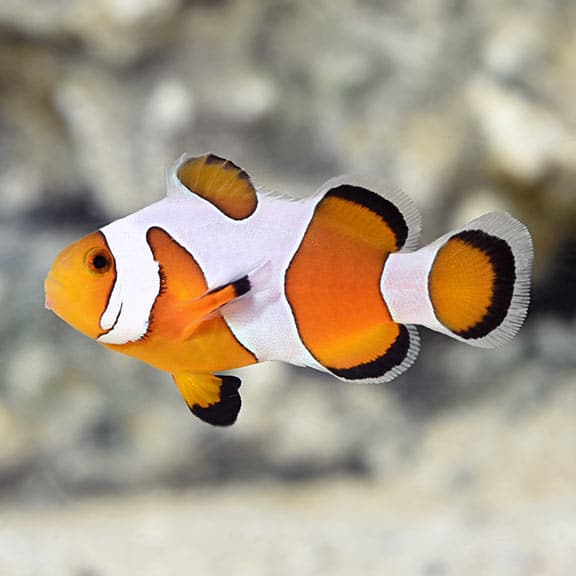Designer clownfish are selectively bred variations of common clownfish species, primarily Ocellaris (Amphiprion ocellaris) and Percula (Amphiprion percula). These unique morphs have been developed in captivity through selective breeding programs, resulting in distinct patterns, colors, and markings that do not typically occur in the wild. They retain the same care requirements and personality as their wild counterparts but offer striking visual differences, making them highly sought after in the aquarium trade.
Popular Types of Designer Clownfish
1. Snowflake Clownfish (Amphiprion ocellaris)
• Appearance: Features irregular white markings across the body, resembling snowflakes.
• Variation: Comes in regular, premium, and ultra-grade, depending on how extensive the white markings are.
• Temperament: Peaceful, similar to standard Ocellaris.
2. Wyoming White Clownfish (Amphiprion ocellaris)

• Appearance: Fully white body with black outlining on the fins.
• Variation: Some have thicker or broken black edges depending on breeding lines.
• Temperament: Peaceful, good for reef tanks.
3. Gladiator Clownfish / DaVinci Clownfish (Amphiprion ocellaris)

• Appearance: Elegant, swirling white patterns across an orange or black body.
• Variation: Available in Grade A, B, and C, with Grade A having the most connected white markings.
• Temperament: Active but peaceful.
4. Black Storm Clownfish (Amphiprion ocellaris)

• Appearance: Jet-black body with large irregular white patches, giving a dramatic contrast.
• Variation: Some have more black than white, others are more balanced.
• Temperament: Hardy and easygoing.
5. Phantom Clownfish (Amphiprion ocellaris)

• Appearance: Black and white body with unique, jagged white stripes.
• Variation: Some have thicker white patterns, while others have almost a “masked” look.
• Temperament: Semi-aggressive, especially in pairs.
6. Picasso Clownfish (Amphiprion percula)

• Appearance: Thicker and more irregular white bands than standard Percula Clownfish.
• Variation: Regular Picasso, Premium Picasso, and Platinum Picasso, with premium varieties having more exaggerated patterns.
• Temperament: Peaceful but territorial when mature.
7. Platinum Clownfish (Amphiprion percula)

• Appearance: Completely white body with black fins and a black-tipped tail.
• Variation: Some have a slightly orange snout, while others are pure white.
• Temperament: Hardy and adaptable.
8. Mocha Clownfish (Amphiprion ocellaris)

• Appearance: Rich brown coloration due to a mix of Orange Ocellaris and Black Ocellaris genetics.
• Variation: Mocha Frostbite and Mocha Storm variants add more unique markings.
• Temperament: Similar to Black Ocellaris—peaceful with some territorial tendencies.
9. Longfin Clownfish (Amphiprion ocellaris & Amphiprion percula)

• Appearance: Elongated, flowing fins, giving a graceful swimming style.
• Variation: Can be found in Snowflake, Phantom, and Storm variations.
• Temperament: More docile than standard clownfish.
10. Midnight Clownfish (Amphiprion ocellaris)

• Appearance: Completely black body with no white markings.
• Variation: Some may have a small spot of white on the face or fins.
• Temperament: Peaceful but will defend its territory.
11. Frostbite Clownfish (Amphiprion ocellaris)

• Appearance: A mix of Snowflake and Phantom traits, featuring blue-tinted white bodies with black outlining.
• Variation: Some have more prominent blue hues, while others lean towards black-and-white.
• Temperament: Active and social.
General Care for Designer Clownfish
Despite their unique appearances, designer clownfish have the same care requirements as their wild-type counterparts.
• Minimum tank size: 75L+ (100L+ recommended for pairs or anemone hosting).
• Water temperature: 24–27°C (75–81°F).
• pH range: 8.1–8.4.
• Salinity: 1.020–1.025.
• Water movement: Moderate (mimicking reef conditions).
• Filtration: Good filtration and regular water changes to maintain pristine conditions.
Diet and Feeding
Designer clownfish are omnivorous and need a varied diet to maintain their vibrant colors and health.
• High-quality marine pellets and flakes – Provides essential nutrients.
• Frozen mysis and brine shrimp – Adds protein and enrichment.
• Chopped seafood (shrimp, squid, or fish) – Occasional treats.
• Algae-based foods or spirulina – Supports digestion and immune function.
Feed 1-2 times per day in small portions to prevent overfeeding and maintain water quality.
Compatibility and Tank Mates
Most designer clownfish are peaceful to semi-aggressive, making them great for community reef tanks.
Best tank mates include:
✔ Gobies, Blennies, Firefish, Fairy Wrasses, Basslets.
✔ Other peaceful clownfish varieties (if introduced together).
✔ Reef-safe invertebrates (shrimp, snails, crabs).
Avoid housing with:
❌ Large, aggressive fish (Triggerfish, aggressive Damselfish).
❌ Other clownfish species, unless in an extremely large tank.
❌ Overly timid fish that might struggle with their territorial nature.
Hosting Anemones
Designer clownfish readily form symbiotic relationships with anemones, especially:
• Bubble Tip Anemone (Entacmaea quadricolor)
• Sebae Anemone (Heteractis crispa)
• Magnificent Anemone (Heteractis magnifica)
⚠ Important Notes:
• Anemones require strong lighting (LEDs, T5s, or metal halides).
• Anemones are not necessary for clownfish to thrive.
• Anemones should only be kept by experienced aquarists.
Health and Disease Considerations
Designer clownfish are generally hardy, but they can still be vulnerable to:
• Marine Ich (Cryptocaryon irritans) – Quarantine new fish before introduction.
• Brooklynella (Clownfish Disease) – Affects the gills and mucus layer.
• Bacterial infections – Often caused by stress or injuries.
Keeping stable water conditions, a varied diet, and proper quarantine procedures will help maintain their health.
Lifespan and Long-Term Care
With proper care, designer clownfish can live up to 15 years in captivity. Their unique patterns, hardy nature, and engaging personalities make them a favorite among aquarists.
Why Choose Designer Clownfish?
✔ Unique and stunning color morphs – A variety of patterns to suit any aquarium.
✔ Hardy and adaptable, making them great for beginners.
✔ Can live long lives, up to 15 years in captivity.
✔ Will host anemones if available, but do not require one.
✔ Active and entertaining – Always engaging with their environment.
